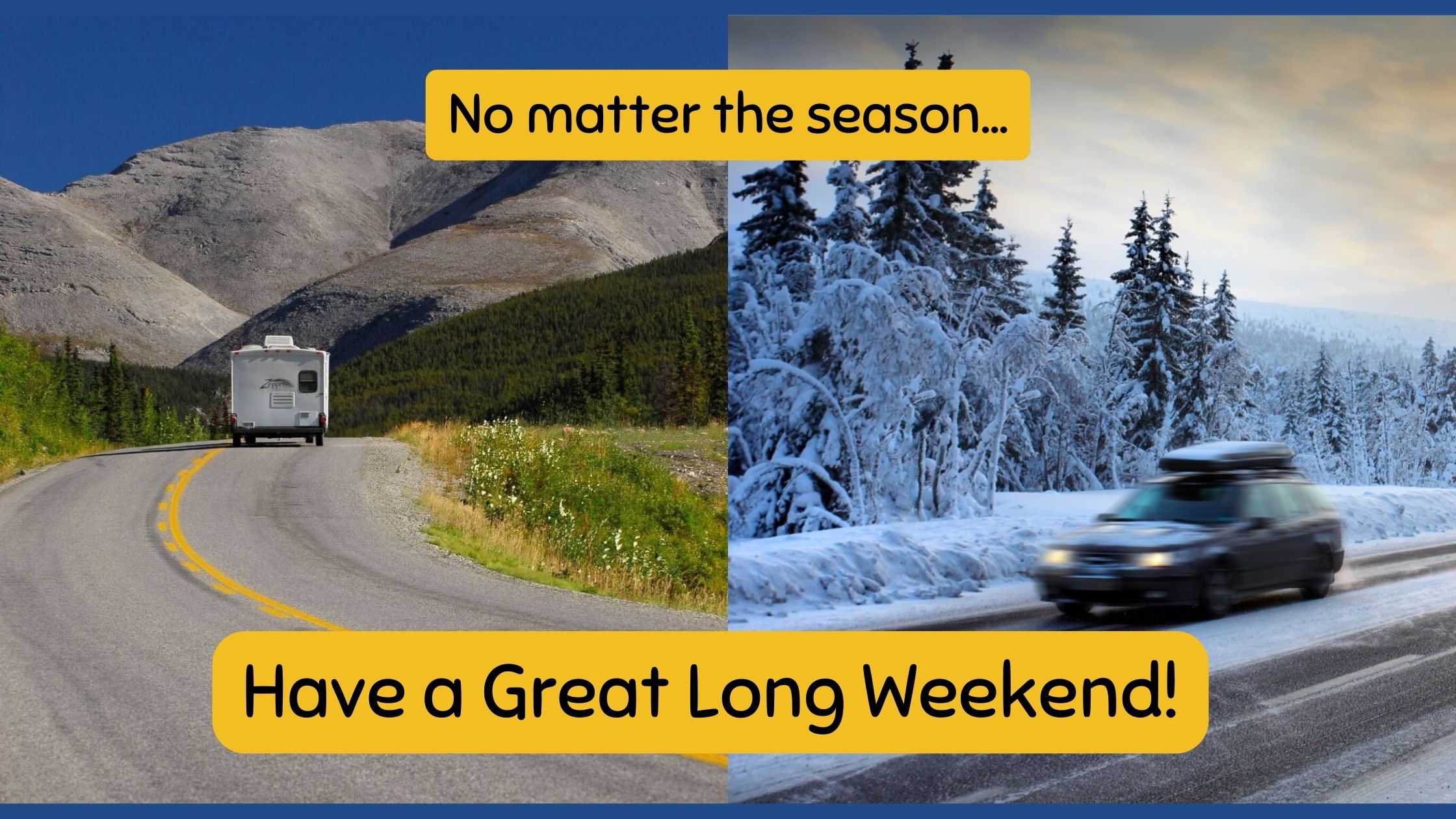
What better way to enjoy the long weekend than getting on the highway and enjoying our provincial backyard?
Whether the extra time off is due to BC Day, Family Day, Thanksgiving or any other summer, winter, fall or spring holiday, plan ahead.
With that extra day can come extra traffic, unpredictable weather, construction delays and longer travel days, so it’s more important than ever to make that one vital driving decision…
To drive safely.
This is especially true with construction on the Coquihalla Highway (Highway 5) and Highway 1 through the Fraser Canyon, where we’re rebuilding after catastrophic damage from November 2021’s unprecedented flooding. Also, work is underway to four-lane the Trans-Canada Highway, from Kamloops to the Alberta.
Know before you go…and…pssst, we can help you with that.
Here are some tips for a safe trip:
- Plan ahead and be realistic about travel times, allowing extra time for delays that can be expected due to increased traffic over the long weekend.
- Check DriveBC.ca or on Twitter @DriveBC for the latest road conditions, weather, incidents, planned events (road construction and maintenance) and special events like parades, races and filming. You can also phone for road conditions toll free at 1 800 550-4997.
- If you’re travelling on Highway 1 (Fraser Canyon), the Coquihalla Highway or the Trans-Canada between Kamloops and Alberta, see our travel advisory information for details about delays on various sections.
- Stay safe by wearing seatbelts, obeying all posted speed limits and, if the weather is bad, slowing down according to road conditions and maintaining a safe following distance.
- Make sure your vehicle is up for the drive by checking engine oil, washer fluid, lights, and tires, including the spare. Prepare yourself, by ensuring you have water aboard and extra supplies should things heat up or cool down and your trip takes longer than expected.
- Put your phone away. Turn off cell phones or store them out of reach to avoid the temptation. Research shows five seconds of texting at highway speeds is like driving blindfolded for almost the length of an entire football field.
And a few more things to be aware of while on the road this long weekend:
- Slow Down Move Over law – applies to all vehicles displaying a flashing red, blue or yellow light. It exists to protect first responders, tow truck drivers and highway maintenance workers who are working roadside. NOTE: This includes Commercial Vehicle and Safety Enforcement and RCMP who may be conducting enforcement.
- Cone Zones – in the summer, nicer weather brings increased construction. Please be aware of roadside workers doing their jobs, and wanting to do it safely. Slow down and obey all traffic control personnel and signs.
- Shift Into Winter – fall and winter weather bring unique and often challenging driving conditions. Many BC highways require winter tires between Oct. 1 and April 30. Make sure you and your vehicle are ready for whatever the weather may bring.
- Hot weather travel requires care and preparation to make sure that you, your passengers and other travellers are safe on the road. Check out our blog to learn more.
- Variable Speed Limit Systems – are now in place in five locations across the province: the Sea to Sky Highway, Highway 1 (from Abbotsford to Chilliwack), Highway 3 (west of Hope), the Coquihalla, and Highway 1, west of Revelstoke. Please pay attention for any speed limit changes while travelling on these corridors.
It’s important to drive safely, not only for you but for your friends and family and for those other travellers on the road. Plan ahead to have a safe and fun long weekend.
I note that there is not a single reference to ‘autonomous’ or ‘self-driving’ in the 2015 interim Traffic Management Manual for work on Roadways (yes, I did search). Were autonomous vehicles considered in the development of this manual? ‘Driver Assist’, ‘Collision Avoidance’ and ‘Autopilot’ are already on the roads and will be common when the manual becomes mandatory practice in 2019.
Hi Nick,
Thanks for your comments and questions about self-driving vehicles. I have forwarded them to our engineering branch and will reply back to you here.
Thank you Nick for your keen interest in the adoption of autonomous vehicles on our provincial highways. The issues that you describe cannot be solely addressed by the 2015 Interim Traffic Management Manual. With vehicle assistance and automation, the driver is still responsible to maintain safe driving skills and behaviour. The interim manual has been written to achieve consistent application of traffic control across the province which has a great influence on driver expectation and therefore safe driving behaviour. This may even lead to industry being able to effectively develop driver assistance and automation which can handle all road environments in BC, including work zones.
Autonomous vehicles will reduce the stress and risks of driving this outdated and overcrowded highway (ICBC called it the most lethal highway in the province). I am particularly looking forward to the replacement of inexperienced, unskilled, tired and heavily time pressured commercial transport drivers by autonomous trucks (I have no problem with the good truckers – there are just far to many bad ones).
However I do worry how autonomous vehicles (oe the human ‘driver’ who is totally unaware of the road around them and suddenly has control of the vehicle dumped back to them) will cope with the months of invisible road markings, the all too common single lane alternating work zones, accident scenes and road closures. And how will autonomous vehicles ‘read’ the variable speed limit signs between Revelstoke and Perry River?
The one way you shouldn’t drive this long weekend (at least if you want to enjoy your drive) – the Trans Canada between Sicamous and the Alberta border.
Autonomous vehicles will change this drive looooonnnnnnngggggg before Kamloops to Alberta 4 laning does.